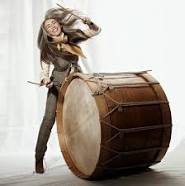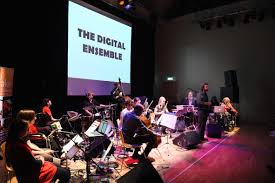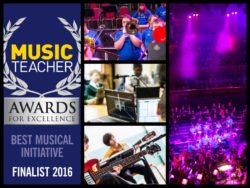Throughout her career, Scottish percussionist Evelyn Glennie has been an intrepid trailblazer. She is the most well-known percussionist in the world and the first person in musical history to create a career as a full-time percussionist (a field traditionally dominated by men). At recent count, over 170 percussion works have been written for her,  she was the first to perform a percussion concerto at the BBC Proms Concerts, and she led an ensemble of 1000 drummers at the Opening Ceremonies of the London 2012 Olympic Games. She has been the recipient of numerous awards and prizes, including 3 Grammy Awards, and she was named a Dame of the British Empire by Queen Elizabeth in 2007. But perhaps the most important trailblazing she has done is as a role model for countless numbers of musicians with disabilities because, as you are no doubt aware, Glennie has been profoundly deaf since the age of 12. (Click on the photo above to hear her in a short percussion montage, and if you are wondering, the first instrument you will see and hear is a waterphone.)
she was the first to perform a percussion concerto at the BBC Proms Concerts, and she led an ensemble of 1000 drummers at the Opening Ceremonies of the London 2012 Olympic Games. She has been the recipient of numerous awards and prizes, including 3 Grammy Awards, and she was named a Dame of the British Empire by Queen Elizabeth in 2007. But perhaps the most important trailblazing she has done is as a role model for countless numbers of musicians with disabilities because, as you are no doubt aware, Glennie has been profoundly deaf since the age of 12. (Click on the photo above to hear her in a short percussion montage, and if you are wondering, the first instrument you will see and hear is a waterphone.)
I have been fortunate to hear Glennie perform live on 3 occasions, twice in London and once at my university (Bucknell), where she played a Vivaldi Concerto for flute, strings, and continuo (arranged for vibraphone by Glennie) with the Luxembourg Philharmonic. That performance lives in my memory as one of my all-time favorites.
Just a few weeks ago, I heard her give a Keynote at the 32nd World Conference of the International Society for Music Education in Glasgow, Scotland. I was at the conference to give a couple of talks about music and the brain, and her keynote was a highlight for me. As she often does, she spoke about how to listen. If you haven’t heard her absolutely marvelous TED talk How to truly listen, check it out. The act of listening won’t be the same experience for you again. Whether performing or speaking, Glennie is a riveting presence onstage and an enormous inspiration for everyone – musician or not; disabled or not.
Glennie’s determination – her compulsion to make music – led her, at the age of 15, to apply to the Royal Academy of Music in London. They turned her down because she was hearing impaired. But she wouldn’t take “no” for an answer and insisted they evaluate her on the basis of her ability – not her hearing impairment. They did, and that decision has had far-reaching consequences beyond the glittering career Glennie has created.
The Royal Academy decision also meant that future applicants were based on ability – not on disabilities, opening the door for many other disabled musicians to receive advanced musical training. And I believe it contributed to more of an awareness of, and creation of more opportunities for, disabled musicians in the UK than one typically finds in the rest of the world.
And that thought leads me to the remainder of this post. There were over 60 performances at the ISME conference by soloists and ensembles (children to adults) featuring a wide variety of traditional and contemporary music from Africa, Asia, North and South America, Europe and Australia. I obviously couldn’t hear all of the performances, but many that I heard were stunning!
But the performances that moved me the most were two by ensembles created for young musicians with special educational needs and disabilities. I have never seen members of any ensemble who seemed happier and more joyful about making music. One of the participating ensembles at the Opening Ceremony was the Drake Music Scotland Digital Orchestra; later in the week I heard the Orchestra of Unlimited Potential. (UP! – love that name!)
Drake Music Scotland, in partnership with major music and arts organizations in the UK, creates opportunities to learn, compose and perform music for children and adults with disabilities. Using digital instruments (including digital drum kits) and a notation called Figurenotes, which  uses shapes and colors to guide players to the right notes, the Digital Orchestra transforms the lives of people with disabilities who want to make music, but usually have no opportunities.
uses shapes and colors to guide players to the right notes, the Digital Orchestra transforms the lives of people with disabilities who want to make music, but usually have no opportunities.
There are two short videos, both on You Tube, that will introduce you to this amazing ensemble: What is the Digital Orchestra? and their performance of The Beginning at the ISME conference.
At their Opening Ceremony performance, I especially noticed one wheelchair-bound young woman with limited control of her arms who was able to play just a few selected pitches on a tablet, enabling her to be part of a real musical ensemble (you will see her on the video). It was incredibly moving to watch the faces of the players in this ensemble as they were performing onstage at this celebratory concert right alongside more “traditional” ensembles such as the Royal Conservatoire Brass, the Scottish Opera Connect Company, and the NYCoS National Girls Choir.
The Orchestra of Unlimited Potential is a project of Surrey Music Hub (England), a network of music organizations and schools that work together to provide more musical opportunities for young people. Music Hubs can be found across the UK and are part of the government’s National Plan for Music  Education. (It would be interesting to know if any portion of their funding comes from the EU, and if so, what will happen to programs like these in the wake of the UK’s decision to withdraw from the European Union.) Within its first year, the UP! Orchestra had already performed at Royal Albert Hall. This promo video clip shows how they prepared for that performance.
Education. (It would be interesting to know if any portion of their funding comes from the EU, and if so, what will happen to programs like these in the wake of the UK’s decision to withdraw from the European Union.) Within its first year, the UP! Orchestra had already performed at Royal Albert Hall. This promo video clip shows how they prepared for that performance.
At the ISME performance, the UP! performers were energized, excited, totally focused on their performance, and they clearly loved playing in this ensemble. A couple of them even took a turn as conductor and commanded the attention of every single member of the group. As you will see in the clips above, they play traditional as well as digital instruments, and they themselves create the works that they perform.
Jim Pinchen, UP! Orchestra project manager says, “Musical instruments are provided to carefully meet the individual needs, abilities and interests of each player. As well as providing access to traditional instruments, cutting-edge technologies are utilised that allow musicians of different abilities to perform in a group using the slightest physical gesture or facial expression.”
We frequently hear the cliché that “Music is a universal language.” It certainly is a language that most of us feel compelled to speak – whether we are simply listening – and tapping or humming along to the rhythm, or whether we are actively making music at whatever level of proficiency we are able to achieve.
An UP! participant’s parent commented “[My child] has always wanted to be part of an orchestra, it is a pretend game we have played for some years- …so you really made his dream come true tonight.”
I find it sad to think of someone pretending to be in an orchestra when making or listening to music seems to be such a universal human need! If we are hardwired for music, as I wrote about in the previous post and in Are we hardwired for music, then perhaps we shouldn’t forget that most people feel compelled to be involved in (or listen to) music in some way – whether a musically challenged Florence Foster Jenkins (previous post) or a physically challenged 10 yr. old who can participate in music making only with the aid of technology. So hats off to Drake Music Scotland and the Surrey Music Hub for creating such wonderful opportunities for disabled musicians to have a real – and meaningful musical experience – one that is great fun for both participants and audience members alike. Now what can the rest of us do??